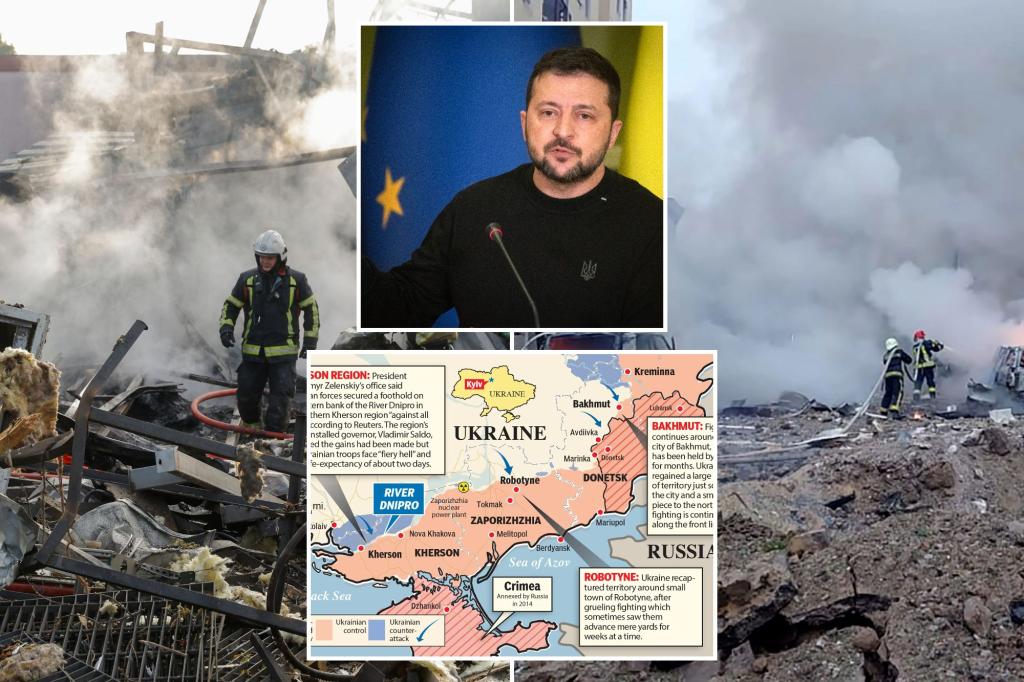The US is at a “crucial decision point” in its involvement in Russia’s Ukraine war, experts warn, as Kyiv’s long-awaited summer offensive has stalled and foreign aid has dwindled.
About 96% percent of the roughly $110 billion the US has allocated to Ukraine since the start of the war in 2022 has been spent, the White House National Security Council announced last week, putting the country’s ability to continue its fight against Russia in jeopardy without further support.
“We have two options,” George Barros, an analyst with the nonpartisan Institute for the Study of War, told The Post. “Number one, [the US] can do an honest, introspective after-action review of Ukraine’s counterattack, and use that to study and realize what worked, what didn’t work… and make our approach better when we give Ukraine what they need.”
“The other option, is that we say the Ukrainian counteroffensive this summer failed… And they cannot afford to do this, no matter how much help we send, and therefore we have to cut our losses while we are still ahead as much as possible and try to push for some kind of negotiation,” said Barros.
Ukrainian soldiers have encountered entrenched Russian troops throughout their ongoing counteroffensive SERGEY DOLZHENKO/EPA-EFE/Shutterstock
“I hope we go for the former, because the latter will not bring any kind of lasting peace,” he added.
After ousting Russia from Kyiv and its northern regions in a spectacular summer 2022 offensive, Ukraine and its allies are hoping to repeat this year’s feat in a major offensive against Russian forces occupying eastern and southern regions.
But following negligible gains since the second offensive was launched in June, Ukraine’s Commander-in-Chief Valery Zaluzhny this month compared the increasingly fortified front line to the “war of position” of World War I.
“The war at the present stage is gradually moving into a position, the way out of which in historical view has always been difficult for both the Armed Forces and the state as a whole,” wrote Zaluzhny in an extensive essay published by The Economist.
Among the obstacles Ukrainian forces have faced in this summer’s offensive are Russian minefields, artillery consolidated behind thick forests, and modern surveillance that eliminates surprise and tactical concealment.
“The simple fact is that we see everything the enemy does and they see everything we do,” Zaluzhny said, describing the state of the battle as a “technological stalemate.”
Without foreign aid from countries like the US, Zaluzhny argued, Ukraine has no chance of fending off Russia — which has a population more than three times larger than Ukraine’s and a more robust economy.
Ukrainian Commander-in-Chief Valery Zaluzhny compared the current battlefield to the stalemate of the First World War.X / @CinC_AFU
“It is a feudal country where the cheapest resource is human life. And for us … the most expensive thing we have is our people,” Zaluzhny said in the accompanying article, explaining that Ukraine would surely be worn thin by Russia without outside help.
Matthew Wallin, chief operating officer of the non-partisan think tank Project on American Security, said such statements about the need for foreign aid are expected from wartime leaders – but in the case of Ukraine they are “probably true.”
“They’re stuck in that position where they’re facing a well-resourced Russian army, with what seems like an almost inexhaustible amount of troops to throw into the fire,” Wallin told The Post. “That’s sort of the traditional Soviet Russian strategy – keep throwing men and women at it until you finally defeat your enemy.”
Ukrainian troops have been fighting for territory on the edge of the yard as they fight to retake their territory in the east and southREUTERS
“Even if they trade power on a one-to-one basis, the Ukrainians will run out of people first. So, Ukraine needs to overcome Russia” he said.
Russia’s strategy has worked. As of October, only about 500 square miles had changed hands since early 2023, according to the New York Times, and while the fighting was bloody on both sides, the toll was greater for Ukraine.
The disappointing results were not entirely the fault of the Ukrainian military – many analysts blamed US politicians for “vacillating” on whether and when to send large supplies such as tanks, minesweepers and fighter jets.
“It looks like a lot of money when you look at it as a whole,” Wallin said of US aid. “But the way we’re slowly rolling out these supplies doesn’t allow Ukraine many coalition forces at the same time to really make a significant push.”
American Abrams tanks finally arrived in Ukraine in mid-September, but many say it is too late to make changesAFP via Getty Images
US-made Abrams tanks only arrived in Ukraine in mid-September – after counter-attacks began – and Ukrainian pilots have only just begun training in American F-16 fighter jets.
“If the political decision to send these things a little earlier had been made earlier, then the system could have been used at the beginning of the operation, not at the tail end or somewhere in the middle where it would not have been as effective,” said Barros .
In October, President Biden asked congress for an additional $61.4 billion in aid for Ukraine. Most Republican opponents have balked when the House debates the 2024 budget, arguing the billions are needed at home.
On Wednesday night, a short-term spending bill was passed to avoid a government shutdown, according to the Associated Press, but it did not include further funding for Ukraine.
As congress quibbled, Ukraine’s counteroffensive led to a deepening cold snap.
President Volodymyr Zelensky reported in a Telegram broadcast Tuesday that Russia has stepped up attacks in the Donetsk region amid counter-attack objectives.
George Barros (left) analyst at the Institute of War, and Matthew Wallin (right) COO of the American Security Project
On the same day, Ukraine said that its troops had crossed the Dnipro River in the Kherson region bordering Crimea, but Russian governor-elect Vladimir Salo vowed that they would enter a “fiery hell,” and that the life expectancy of a Ukrainian soldier in the zone the war there was about two days, Reuters reported.
The war between Israel and Hamas that broke out on October 7 has complicated the situation by dividing the attention of American lawmakers and the public.
In addition to the Ukraine funding, Biden’s aid package includes $14.3 billion in defense spending for Israel, along with $7 billion to reduce China’s influence around Taiwan. Although the Israel portion of the bill passed the Republican-controlled House in early November, it faces gridlock in the Democratic-led Senate and is also not included in a short-term budget deal.
While people have a tendency to “create this false dichotomy” that the US must pick and choose which allies it supports, Barros argues that now is one of the most important moments since the end of the Cold War for the US to support its allies. .
Barros cited China’s growing aggressiveness toward Taiwan, Iran’s support for Hamas’ war against Israel, North Korea’s continued missile tests, and Russia’s attempt to remove NATO influence with its invasion of Ukraine.
“There is this sort of axis of dictators, and they are all aligned in overthrowing the United States and all democratic allies,” Barros said.
“I think this is the time to choose for the West. For those who want to see the United States and our allies continue to be the maintainers of this global order.”
Categories: Trending
Source: thtrangdai.edu.vn/en/



